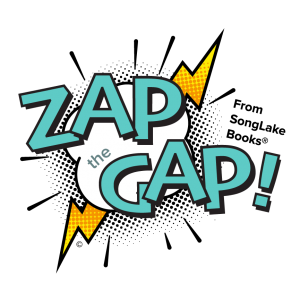Book Collections For Reading Recovery® And Grade 1:

Zap the Gap Collections
Three Set Minimum Per Order
Diversity Collections
Book Collections for Guided Reading
Getting Acquainted


Introduction
Looking for a proven way to mitigate sustained learning interruptions? Worried about the reading progress of struggling readers? Worried about each of your at-home readers? Are harried parents asking for book selections? Then our Zap the Gap book collections are for you!
SongLake Books’ Zap The Gap collections for grades K-4 are intentionally designed to mitigate summer reading loss for struggling readers, but work well for all students not only during the summer, but year round.
As an added bonus, each order placed is packed with one set of Danny’s Reading Recipes, 15 individual recipe cards that children can read and make. (A $10. value!) Compare this price with the cost of running a traditional summer school program. There is no comparison! Interested in learning more about Zap the Gap? Read on.
Rationale
The summer reading “gap” has been well documented. Thanks to the research of Allington, McGill-Franzen, Cahill, Horvath, and others, we have more than enough evidence that ACCESS, CHOICE and READABILITY can mitigate the summer reading gap for disadvantaged children and our Zap the Gap book sets have been designed to meet these criteria. On average disadvantaged readers lose two months of reading progress each summer, while more advantaged students gain one month, accounting for a three month reading “gap” which is cumulative from summer to summer.
ACCESS: Less privileged children have less access to books, especially during the summer months. They have fewer reading materials at home, a scarcity of libraries in their neighborhoods, and few if any bookstores available. Parents cannot afford to buy books for their children particularly now during the COVID-19 pandemic when jobs are in peril, bills are due, and prices are skyrocketing. Our Zap the Gap collections help children develop their own home libraries.
CHOICE: When given a choice of books, children are more eager to read, achieve more and have a better attitude toward reading. Richard Allington’s 3-year summer reading study in 17 urban and rural schools had struggling readers self-select 10-12 books for a summer giveaway program. In three successive summers, these children were able to curb their summer reading slide and show enthusiasm for reading. Unable to have students self-select books, SongLake Books did the next best thing. We researched many summer reading programs and best practices and carefully selected titles that children themselves chose time and time again. Most popular were books in a series. Just as we as adult readers have our favorite authors, children have theirs. There are many benefits to reading books in a series. As characters become familiar, books become more predictable and easier to read. Therefore, we included many series books like the Bella and Rosie books (Pioneer Valley Books), the Danny books (MaryRuth Books), the Spider books (RR Books), the Charlie and Fluffy books (Blueberry Hill Books), as well as Captain Underpants, Goosebumps, the Black Lagoon series, Babymouse, Bad Kitty, Geronimo Stilton, and more. Next, boys and girls alike chose animal books, especially sharks and reptiles, so we included these as well. Students also selected books with humor, books with visual appeal, sport celebrities, pop culture, and graphic novels. Some even selected cookbooks! Given 20 of these most popular titles, students will have no difficulty choosing a minimum of 10-12 favorites and be eager to read.
READABILITY: To assure that the 20 books are at the child’s independent level, books they can read with a minimum of difficulty, we created sets spanning only two levels. For example, kindergarten levels usually span ABCD. Therefore, we created an AB set and a BC set. If a child is reading independently at Level A, then Set AB would give that child 10 books he/she could read easily and 10 books only slightly more difficult at Level B. Since grade 1 spans DEFGHIJ we created 5 different sets covering DE, EF, FG, GH, and HI with the same idea in mind. Likewise, for grade 2: JK and KL; grade 3: MN and NO; and grade 4: PQ and QR. Given so many choices, the teacher can easily match student readability to the appropriate book set.
It’s easy to see why all ability groups would benefit from SongLake Books’ Zap the Gap sets for summer reading or year-round reading, whether at home or in school.
Suggestions for Use
Scenario 1: Sets can be given to struggling readers to develop their own home libraries. Sound alarming? Give books to struggling readers for free? Unheard of! And yet that is just what Allington and his colleagues did with 1300 low-income students with surprising results. Given a choice of readable books for keeps, these kids were actually eager to read! The result: no reading gap.
Scenario 2: Present the book set to the student saying, “I’ve selected these ‘just right’ books especially for you so you could have your own home library. Look each book over and select your top ten favorites to read over the summer. Read even more if you wish. Let me know which ones you enjoy the most. No tests. No book report. No dioramas. Just share with someone (mom, dad, brother, sister, friend) which were your favorites and why.”
Scenario 3: In this day of “zooming” the teacher can spread the titles out on her table and have the student select five favorites to read over the next few weeks. Send them home. After a few weeks ask the student to share which story he/she liked best and why. Ask if there were any books he/she did not like and would like to return. Then spread out the remaining titles and ask him/her to select a new five books to read.
Scenario 4: Alternatively, sets could be loaned to students and returned at summer’s end. Students could be loaned a set of all 20 books and asked to read at least 10. They could keep 2 of their very favorites and return the rest.
Scenario 5: Arrange a mid-summer book swap. Children can return less favorite books to swap for different ones.
Other suggestions: Some schools have set up a “bookmobile” delivering books to students on a regular basis. Other schools have buses make “lunch runs” and perhaps they could incorporate “book drop-offs” as well.
We are confident that each school can adapt our Zap the Gaps to each unique situation. Now the only thing left to do is select which sets work best for your students! Since each classroom typically has a minimum of 3 below average readers, we have set a minimum of 3 sets per order in any combination. And don’t forget the complimentary recipe cards with each order. You can divvy them up or let students select one or more of 15 cards when they select their books. Lastly, don’t hesitate to reach out to Sarah or me with questions, suggestions, or just to let us know how our Zap The Gaps are working. We are always here to help!
SongLake Books, LLC
PO Box 208
Tully, NY 13159
Phone 888.588.6200 or 315.696.5506
Fax 888.979.1500 or 315.696.0192
Contact Carol via Email
Contact Sarah via Email
